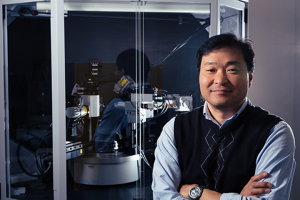Silicon, despite inefficiencies, has been an effective electrical energy conversion and control material for hybrid-electric vehicles and numerous other power electronics. However, the semiconductor is reaching its physical limits in many important applications, such as next-generation electric vehicles and smart grid systems.
A professor at the University of Houston is exploring the use of gallium nitride, GaN, as a more energy-efficient semiconductor alternative to silicon, Si, which is the most dominant material currently used. Jae-Hyun Ryou, assistant professor of mechanical engineering in the Cullen College of Engineering, recently earned a three-year, $270,000 grant from Technology Engine of Science to develop a high-current, high-voltage switching and conversion device to power the next generation of electronics.
Silicon material has reached its maximum capacity in power conversions, and gallium nitride has potential to close the inefficiency gaps, Ryou said. In electric power grids, for example, silicon semiconductor switching devices that regulate voltage and currents of electricity in distribution lines cannot be closed above a particular voltage, which results in huge energy losses. Silicon devices only optimize electricity flow below certain voltage levels.
Researchers have already demonstrated proof-of-concept for the emerging gallium nitride semiconductor technology. Ryou and his UH engineering team, which includes Seunghwan Kim, post-doctoral research fellow, and Weijie Wang and Shahab Shervin, both doctoral students, are collaborating with the University of Texas-Dallas, the Korea Institute of Industrial Technology and the Technology Engine of Science. Together, their goal is to design and construct the switching device using gallium nitride, which is commonly used by researchers for various purposes. In fact, three researchers won the Nobel Prize in physics this year for their application of the compound to the development of blue light-emitting diodes, or LEDs.
“We hope to further expand the practical use of GaN in other applications beyond the LEDs,” Ryou said.
Unique physical and chemical properties of gallium nitride provide technical benefits for demanding applications. The semiconductor material, which is more thermally and chemically stable than silicon, permits devices to operate at higher voltages, frequencies and temperatures than their silicon-counterparts. In fact, gallium nitride can carry electrical currents at three times the velocity of silicon, and the material withstands breakdown 10 times better than silicon.
To develop the new semiconductor technology, Ryou and his team must overcome technical challenges. They must minimize imperfections in the gallium nitride material through an innovative chemical vapor deposition process used to produce thin high-performance films in the semiconductor industry. Furthermore, the researchers must develop the material structure at the maximum performance suggested by theoretical studies in order to demonstrate high-performing devices.
Ryou is performing the theoretical modeling of materials and devices. Technology Engine of Science and other collaborators possess the capabilities to develop and manufacture the devices.
“We want to have a prototype device that can be applied to any power conversion applications at the end of the three-year grant,” Ryou said.
